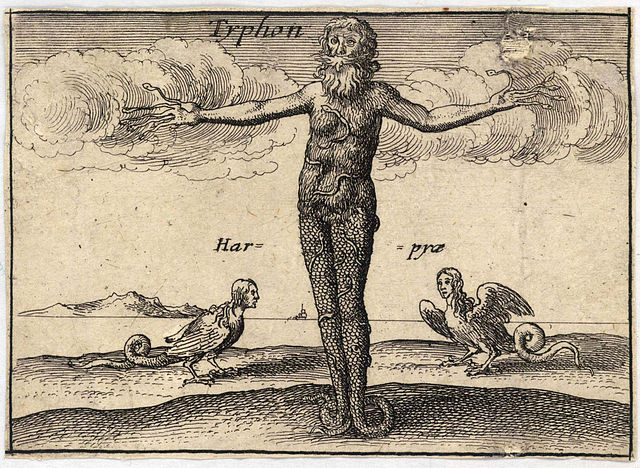Typhon, also Typhoeus, Typhaon or Typhos, was a monstrous serpentine giant and one of the deadliest creatures in Greek mythology. According to Hesiod, Typhon was the son of Gaia and Tartarus. However, one source has Typhon as the son of Hera alone, while another makes Typhon the offspring of Cronus. Typhon and his mate Echidna were the progenitors of many famous monsters.
Zeus aiming his thunderbolt at a winged and snake-footed Typhon. Chalcidian black-figured hydria (c. 540–530 BC), Staatliche Antikensammlungen (Inv. 596).
Depiction by Wenceslas Hollar
The three-bodied daemon, perhaps Typhon. Acropolis Museum, Greece.
Tarhunna battles the serpent Illuyanka, Museum of Anatolian Civilizations, Ankara, Turkey.
In Greek mythology, Gaia, also spelled Gaea, is the personification of Earth. Gaia is the ancestral mother—sometimes parthenogenic—of all life. She is the mother of Uranus (Sky), from whose sexual union she bore the Titans, the Cyclopes, and the Giants; as well as of Pontus (Sea), from whose union she bore the primordial sea gods. Her equivalent in the Roman pantheon was Terra.
Gaia pleads Athena to spare her son, Gigantomachy frieze, Pergamon Altar, Pergamon museum, Berlin.
Gaea by Anselm Feuerbach, 1875 ceiling painting, Academy of Fine Arts Vienna.
Gaia hands her newborn, Erichthonius, to Athena as Hephaestus watches – an Attic red-figure stamnos, 470–460 BC
Gaia entrusts Erichthonios to Athena. From left to right: Hephaestus, Athena, Erichthonios, Gaia, Aphrodite. Said to come from the temple of Hephaestus in Athens. Pentelic marble. 100-150 AD. Louvre








